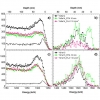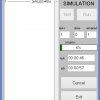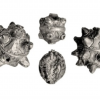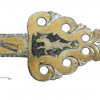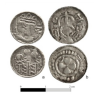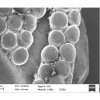Nuclear Microanalysis Lab
Lab Head: Dr. Cyprian Mieszczyński
email: Cyprian.Mieszczynski@ncbj.gov.pl
Basic structural properties of modern materials for nuclear power industry, microelectronics, and optoelectronics are studied in the Lab using ion-based analysis techniques (RBS, NRA, PIXE) and the channelling phenomenon. A strong emphasis is placed on:
• quantitative analyses of thickness/stoichiometry of various layers
• evaluation of material crystallographic quality
• taking depth distribution of elements in doped materials
• accumulation/transformation of post-implantation defects in crystals
• optimization of annealing processes (RTA, FLASH)
• impact of annealing on depth distribution and evolution of post-implantation defects as well as on lattice locations and in-depth migration of dopants.
Random and aligned RBS/c spectra taken on ZnO mono-crystal implanted with 5x1014 Yb ions/cm2 (a, b) and 1x1015 Yb ions/cm2 (c, d) then annealed using various techniques. RTA: 10 min at 800⁰C. FLA: 20 ms, energy 110 J/cm2.*
Graphical User Interface of the most recent McChasy simulation software
The Lab is involved in validation of McChasy, a globally unique Monte Carlo-based simulation software developed to analyse experimental data acquired with the help of the ion-based analysis techniques. The program is among a few software packages in the world capable to analyse RBS spectra taken in the channelling direction. To our best knowledge it is an only software capable to differentiate simple and compound defects in surface-modified materials.
The lab applies also various analytical techniques (including XRF, SEM-EDX, INAA, LA-ICP-MS) to extend our knowledge on origin, manufacturing technology, and raw materials of archaeological artefacts. Mainstream archaeometry activities include elemental/chemical composition (XRD and Raman spectroscopy) and structural (X-ray and neutron radiography) analyses of objects made of some metal alloys, but glass/ceramic/bone/glazed objects are also tested. Some members of the archaeometry team in our Lab represent NCBJ in the ERIHS-PL consortium that associates 16 Polish research institutes into an European platform actively conducting research on cultural heritage.
Silver beads from the Rajsków-Słuszków treasure (the Wielkopolskie region of Poland) dated for X-XI century.
A part of an ornamental horse trappings dated for late Migration Ages (III-V century AC) from a votive site within former Nidajno lake (community Piecki, county Mrągowo).
Sieciech paladin coins (dated XI century)
SEM-SE image taken of a brazing area in an ornament characteristic for early medieval ages. The solder has been made using the so-called diffusive solder technique
We have been tightly cooperating with other labs both in NCBJ and in other research institutes home and abroad, including Polish Academy of Sciences (PAS) Institute of Physics in Warsaw, Warsaw University Institute of Archaeology, Gdańsk University Institute of Archaeology, PAS Institute of Archaeology and Ethnology in Warsaw, State Archaeological Museum in Warsaw, Institute of Electronic Technology in Warsaw, Institute of Electronic Materials Technology in Warsaw, Helmholtz-Zentrum Dresden Rossendorf (Germany), Paris-Sud University (France), CNRS (France).
Our scientific results have been published in numerous papers published by recognized scientific journals and/or presented on numerous scientific conferences.
* R.Ratajczak, S.Prucnal, E.Guziewicz, C.Mieszczynski, D.Snigurenko, M. Stachowicz, W. Skorupa and A. Turos, The photoluminescence response to structural changes of Yb implanted ZnO crystals subjected to non-equilibrium processing, J. Appl. Phys. Vol. 121 (2017) 075101.











